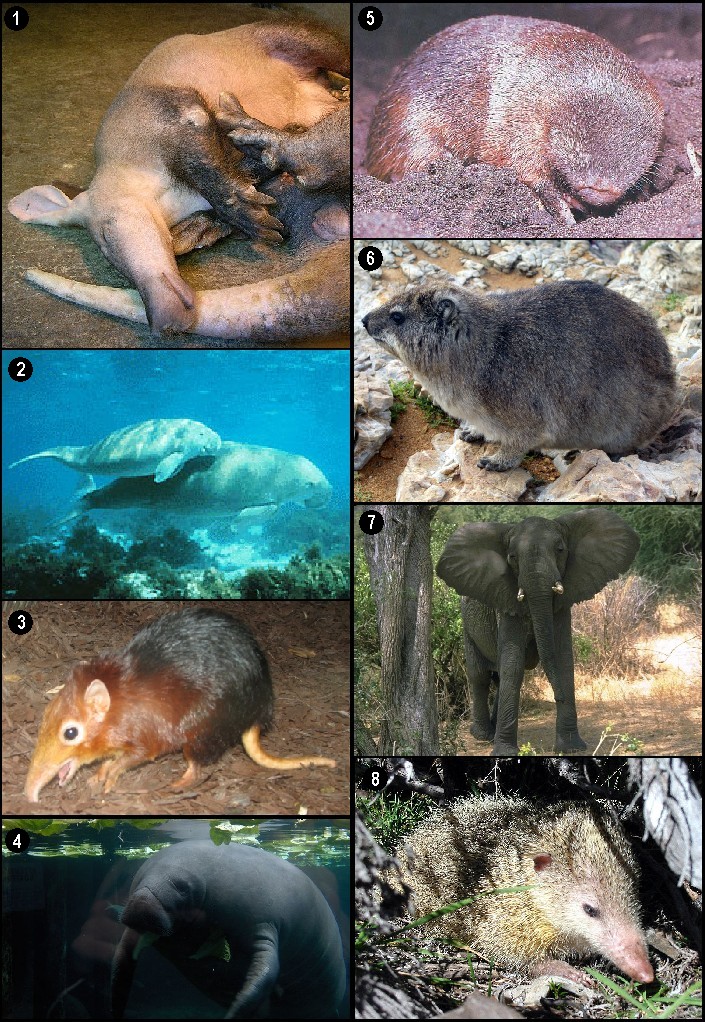- Afrotheria
Taxobox
name = Afrotheria
fossil_range =Paleocene - Recent

image_width = 250px
image_caption =1."Orycteropus afer " 2."Dugong dugon " 3."Rhynchocyon petersi " 4."Trichechus manatus " 5.Chrysochloridae sp. 6."Procavia capensis " 7."Loxodonta africana " 8."Tenrec ecaudatus "
regnum =Animal ia
classis =Mammal ia
infraclassis =Eutheria
superordo = Afrotheria
superordo_authority = Stanhope et al., 1998
subdivision_ranks = Orders
subdivision = See BelowAfrotheria is a
clade ofmammal s with the rank ofsuperorder orcohort , containing (among others) thegolden mole s,elephant shrew s,tenrec s,aardvark s,hyraxes ,elephant s andmanatee s.Evolutionary relationships
Afrotheria has been proposed based solely on molecular &
DNA analyses. Genetic analyses since the 1990s have identified Afrotheria as one of four major groups within the infraclassEutheria (containingplacental mammals ). Exact relations among the four cohorts, Afrotheria,Xenarthra ,Laurasiatheria , andEuarchontoglires (aka Supraprimates) remain somewhat controversial. One reconstruction proposes that the oldest split was between Afrotheria and the other three some 105 million years ago when the African continent was separated from other major landmasses. (The name Afrotheria was coined from two roots, Afro- for 'Africa' and -theria meaning 'animal' in Greek.) Genetic analysis and the fossil record suggests that Xenarthra developed in South America and diverged from the remaining two somewhat later. Laurasiatheria and Euarchontoglires are more closely related than the other two cohorts and may be grouped together within the taxonBoreoeutheria .Some researchers consider these classifications based on recent comparative DNA analysis to be preliminary or controversial, as they often cut across previous groupings of mammalian relationships that were based on morphological considerations. For example, the order
Insectivora , which comprised many genera and species of mostly small, insect-eating mammals, now appear to be only distantly related, and apparently share similar anatomy and behaviors primarily as the result ofconvergent evolution . [See the Kriegs et al. (2001) paper for discussion of a number of possible reconstructions of cohorts and other clades based on different forms of genetic and morphological evidence. They believe that theRetrotransposon presence/absence data produces fewer errors than other existing methods of taxonomic reconstruction.] As another example, distinctive morphological features of the Xenarthra (which includes anteaters, sloths, and armadillos) previously led taxonomists group all other Eutherian mammals into the taxonEpitheria , with Xenarthra as the most distantly related grouping. Yet another reconstruction would place Xenarthra and Afrotheria together within the cladeAtlantogenata as a sister clade to the Boreoeutheria.Current status
Many members of Afrotheria appear to be at high risk of extinction; if the grouping is accurate, this would be a particularly devastating loss of genetic and evolutionary diversity. The [http://www.calacademy.org/research/bmammals/afrotheria/ASG.html Afrotheria Specialist Group] notes that Afrotheria as currently reconstructed includes nearly a third of all mammalian orders currently found in Africa and Madagascar, but only 75 out of more than 1200 mammalian species in those areas. While most extant species assigned to the cohort Afrotheria are found in Africa, some (such as the Indian elephant and the three species of manatee) are found elsewhere; many of these are endangered as well.
Organization
Afrotheria is a division of the infraclass
Eutheria or Placentalia and groups together six living orders ofmammals :
* INFRACLASS EUTHERIA: placental mammals
** Superorder Afrotheria [Seiffert (2007) provides an overview of possible resolutions to the polytomy of Afrosoricida, Macroscelidea, Tubulidentata, and Paenungulata. There is currently no broadly supported consensus on this aspect of afrotherian phylogeny.]
**** OrderAfrosoricida
***** SuborderChrysochloridea : golden moles (21 species)
***** Suborder:Tenrecomorpha : tenrecs and otter shrews (32 species)
**** OrderMacroscelidea : elephant shrews or sengis (15 species)
**** OrderTubulidentata : aardvark (1 species)
*** CladePaenungulata
**** OrderHyracoidea : hyraxes (4-6 species, depending on classification of subspecies)
**** OrderProboscidea : elephants (3 species)
**** OrderSirenia : manatees (3 species) dugong (1 species) and several extinct species ofsea cow
**** OrderEmbrithopoda : extinct
**** OrderDesmostylia : extinct
** SuperorderXenarthra
**taxon Boreoeutheria
*** SuperorderLaurasiatheria
*** SuperorderEuarchontoglires (Supraprimates )Classification problems
Afrotheria are believed to have originated in
Africa at a time when the continent was isolated from other continents. The only externally visible common characteristics are the movable snout and testicondy (lack of a scrotum in males), although there is no convincing evidence that this structure is in fact homologous across all members of this group.The biggest problem with considering Afrotherians as an originally African clade is the
fossil record . The earliest fossil evidence for African ungulates and elephant shrews are found outside Africa.Fact|date=September 2008 The Afrotheres are part of the proposed cladeAtlantogenata .Afrotherian
monophyly is not universally accepted, and morphological evidence places the elephants and their relatives astrue ungulate s. This may also be the case for the aardvarks and the elephant shrews, although not the tenrecs and golden moles, and the elephant shrews may be related to gnawing mammals (withinGlires ). A mammal known fromMadagascar ("Plesiorycteropus ") is of unknown affinities but may also be an ungulate perhaps related to the mainland aardvark. Some morphological evidence does support the affinity of the tenrecs and golden moles to otherLipotyphlan insectivores, especially to "Solenodon " in theCaribbean region. This is a more traditional interpretation of Tenrecomorph relationships.References
*cite journal|author=Kriegs, Jan Ole, Gennady Churakov, Martin Kiefmann, Ursula Jordan, Juergen Brosius, Juergen Schmitz|year=2006|title=Retroposed Elements as Archives for the Evolutionary History of Placental Mammals|journal=PLoS Biol|volume=4|issue=4|pages=e91|doi=10.1371/journal.pbio.0040091 ( [http://biology.plosjournals.org/perlserv/?request=get-pdf&file=10.1371_journal.pbio.0040091-S.pdf pdf version] )
*cite journal|author=William J. Murphy, Eduardo Eizirik, Mark S. Springer et al.|title=Resolution of the Early Placental Mammal Radiation Using Bayesian Phylogenetics|journal=Science|volume=294|issue=5550|pages=2348–2351|date=14 December 2001|doi=10.1126/science.1067179|pmid=11743200
*cite journal|author=Seiffert, Erik|year=2007|title=A new estimate of afrotherian phylogeny based on simultaneous analysis of genomic, morphological, and fossil evidence|journal=BMC Evolutionary Biology|volume=7|issue=|pages=13|doi=10.1186/1471-2148-7-224 ( [http://www.biomedcentral.com/content/pdf/1471-2148-7-224.pdf pdf version] )Notes
External links
* [http://www.calacademy.org/research/bmammals/afrotheria/ASG.html IUCN species survival commission: Afrotheria specialist group. Information on the member of Afrotheria, with pictures.]
Wikimedia Foundation. 2010.
